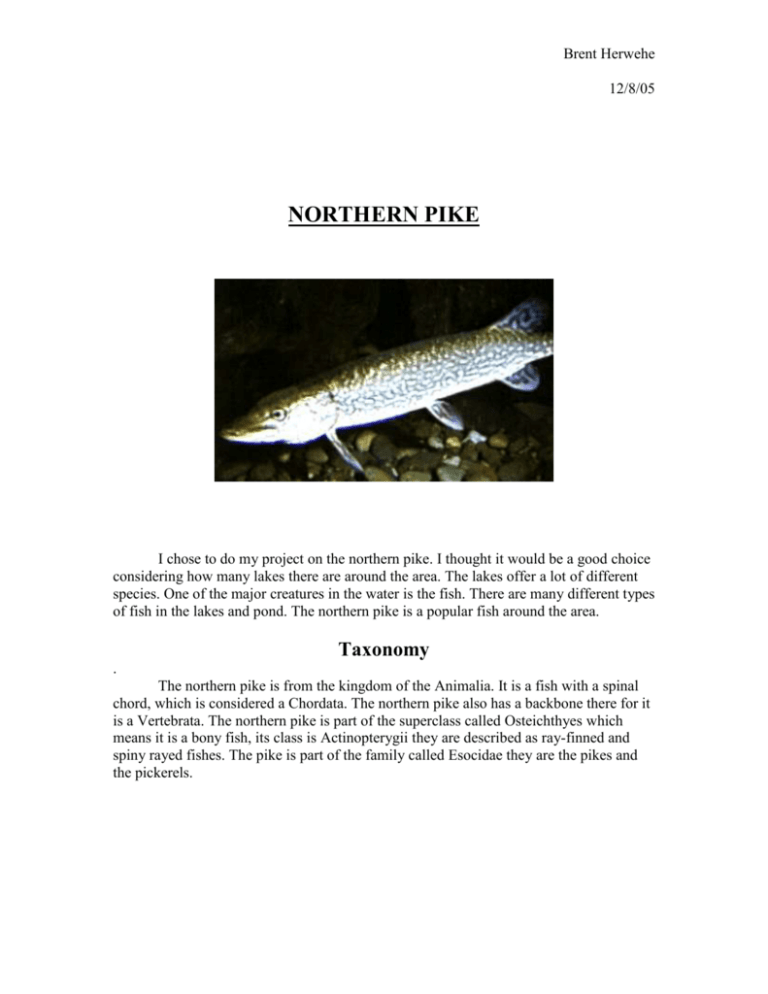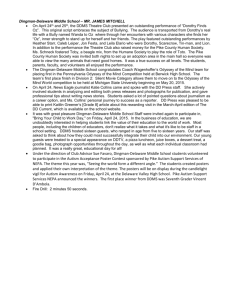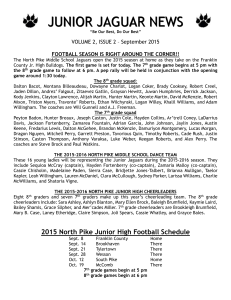NORTHERN PIKE
advertisement

Brent Herwehe 12/8/05 NORTHERN PIKE I chose to do my project on the northern pike. I thought it would be a good choice considering how many lakes there are around the area. The lakes offer a lot of different species. One of the major creatures in the water is the fish. There are many different types of fish in the lakes and pond. The northern pike is a popular fish around the area. Taxonomy . The northern pike is from the kingdom of the Animalia. It is a fish with a spinal chord, which is considered a Chordata. The northern pike also has a backbone there for it is a Vertebrata. The northern pike is part of the superclass called Osteichthyes which means it is a bony fish, its class is Actinopterygii they are described as ray-finned and spiny rayed fishes. The pike is part of the family called Esocidae they are the pikes and the pickerels. Brent Herwehe 12/8/05 Habitat The Northern pike is native to Ohio and is more widely distributed than any other pike species. Historically, they were abundant in Lake Erie and its tributaries. It is also thought to have been present in some parts of the Ohio River. Today, its supply is limited to a small portion of Lake Erie, Sandusky Bay, Maumee Bay and the marshlands and tributary streams of these areas. Northern pike were also introduced into inland waters between 1950 and 1980. The northern pike prefers shallow, weedy, clear waters in lakes and marshes, but also inhabits slow streams. After ice-out, they move further into shallows and marshes to spawn, retreating to deep, cool waters (65º or less) in summer. The smaller northern pike like to remain in shallow weedy waters through much of the year, due to bigger fish that might harm them. Status The status of northern pike is actually unknown, but a few studies have reported the presence of Northern Pike in some lakes on the Yukon North Slope and in Deep Creek. Life History Brent Herwehe 12/8/05 Northern pike spawn in Lake Erie tributaries as soon as the ice breaks, usually in late February or early March. Females spread between 15,000 to 75,000 eggs freely into vegetated areas. As the eggs settle they adhere to vegetation, rocks, sticks and other debris until they hatch in about two weeks. Young Northern pike feed on zooplankton for about two weeks and then begin switching to a diet of fish. After spawning, females return to the bays, marshes and Lake Erie. Adult pike feed primarily on fish but will take nearly anything they can fit in their mouth, including frogs, muskrats, and small ducks. Food Habits The northern pike is private and highly protective, it lurks at the edge of weed beds and attacks unwary creatures that enter its domain, such as fish, crayfish, frogs, mice, muskrats and young waterfowl. It is an opportunist that can be best described as an omnivorous carnivore, as it feeds on whatever is most willingly available. Brent Herwehe 12/8/05 Breeding Pike generally spawn in late March or early April in reed beds or in shallow streams. The number of eggs produced depends on the size of the fish. The larger the fish, the more eggs it produces. The eggs remain on or just above the bottom of the lake or stream until they hatch two to three weeks later. Larvae feed off the york save for 10 days, until it is completely absorbed. The pike are then ready to hunt for be preyed on. Chromosome # Chromosome test were performed on tumor cells and normal hematopoietic cells of northern pike nasty lymphomas. The normal pike karyotype contains 50 acrocentric chromosomes, among which the sex chromosomes are not identifiable by available by the eye. Metaphases from 19 primary lymphomas showed a consistent pattern of chromosome anomalies consisting of 1 submetacentric marker, 1 minute marker, and 3 to 5 pairs of smaller-than-normal chromosomes, set within a mode of 50 and a range of 46 to 54. Occasional cells had 2 identical submetacentric markers. Cells from presumptively normal hematopoietic tissue in 41 lymphoma-bearing pike showed the euploid karyotype, with the exception of 2 cases in which some cells with the neoplastic pattern were found. This probably indicated occult neoplastic involvement of renal hematopoietic tissue, in spite of the absence of histological evidence of involvement. In many cases, some of the cells taken directly from lymphomas turn off the normal karyotype.. The findings do not show a conclusion regarding agent versus cellular transmission. Brent Herwehe 12/8/05 Behaviors Northern pike are opportunistic, big feeders programmed to eliminate the weak. Their coloring varies and often depends on the waters where the fish can be found, an evolutionary development that relates to their ability to conceal themselves. In clear water under a bright sun, their visual acuity is excellent, especially upward and to either side, which allows them to cover up while scanning their territory for another victim. The inner ear and a long lateral line detect the slightest vibration, another advantage in locating prey. Once located, that prey doesn’t have a chance.







